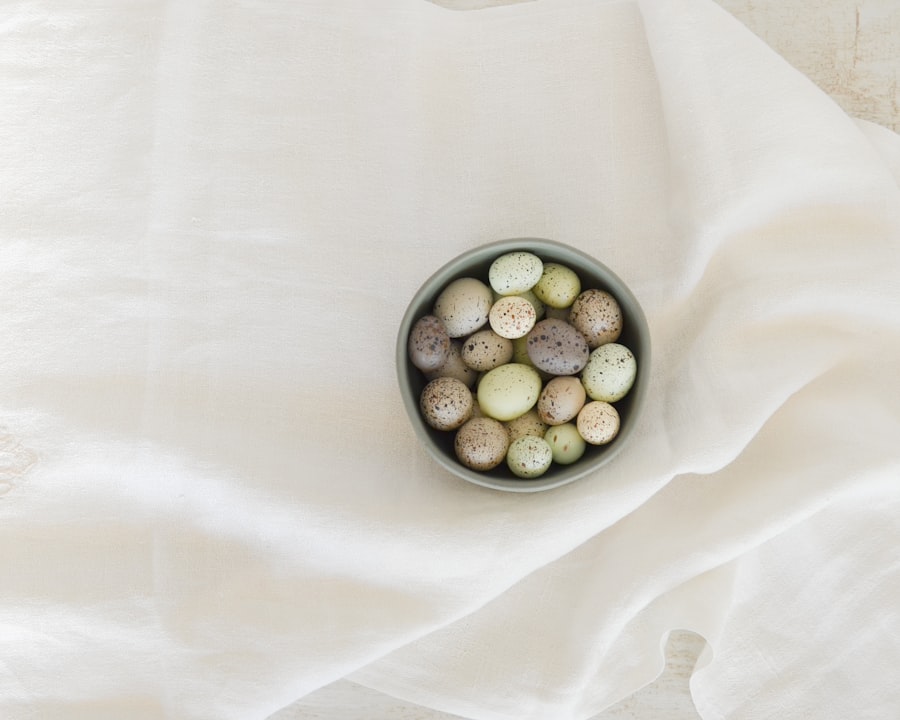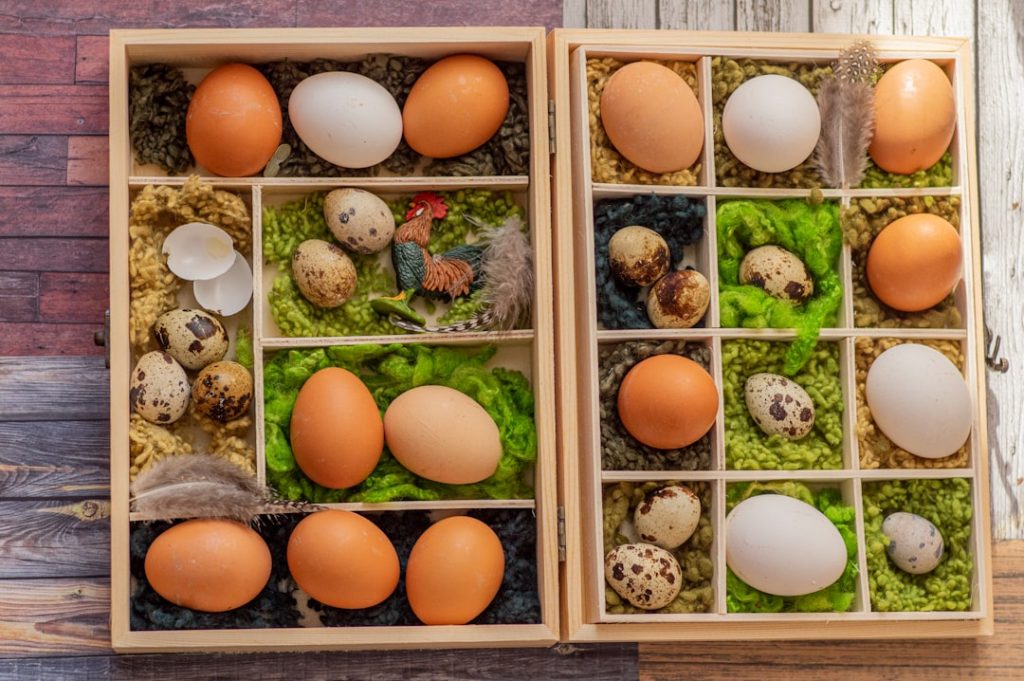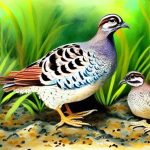Celadon quail, also known as Coturnix japonica, are a popular breed of quail known for their beautiful blue-green eggs. Breeding these quail can be a rewarding and enjoyable experience for both novice and experienced breeders. Celadon quail are relatively easy to care for and breed, making them an ideal choice for those looking to start a small-scale quail breeding operation.
Breeding celadon quail requires careful selection of breeding stock, creating the ideal breeding environment, understanding breeding behavior, and properly incubating and hatching eggs. Additionally, caring for chicks and young quail is essential for their health and development. Breeding for desired traits such as egg color, size, and temperament is also an important aspect of celadon quail breeding. In this article, we will explore each of these aspects in detail to provide a comprehensive guide to breeding celadon quail successfully.
Table of Contents
Key Takeaways
- Celadon quail breeding requires careful selection of breeding stock to ensure desired traits
- The ideal breeding environment for celadon quail includes proper housing, nutrition, and space
- Understanding breeding behavior is crucial for successful celadon quail breeding
- Incubating and hatching celadon quail eggs requires attention to temperature and humidity levels
- Caring for chicks and young quail involves providing proper nutrition and a safe, clean environment
Selecting Breeding Stock
Selecting the right breeding stock is crucial for successful celadon quail breeding. When choosing breeding stock, it is important to select healthy, disease-free birds with desirable traits such as good egg production, strong eggshell color, and good temperament. Look for birds that are active, alert, and have a good body conformation. Avoid birds that are too small or too large, as they may not produce the desired offspring.
It is also important to consider the genetic diversity of the breeding stock to avoid inbreeding and maintain the overall health and vigor of the flock. When selecting breeding stock, choose birds from different bloodlines to ensure genetic diversity. Additionally, consider the egg color and size of the potential breeding stock, as these are important traits that will be passed on to the offspring. By carefully selecting breeding stock with desirable traits and genetic diversity, you can lay the foundation for a successful celadon quail breeding program.
Creating the Ideal Breeding Environment
Creating the ideal breeding environment is essential for successful celadon quail breeding. The breeding environment should provide adequate space, proper ventilation, and protection from predators. Quail are social birds and should be kept in groups to prevent stress and aggression. Provide at least 1 square foot of space per bird in the breeding environment to ensure they have enough room to move around comfortably.
The breeding environment should also include nesting boxes or areas where the quail can lay their eggs. These nesting areas should be dark and secluded to provide a sense of security for the birds. Additionally, provide a balanced diet that includes high-quality quail feed, fresh water, and access to grit for digestion. Proper lighting is also important for stimulating egg production, so ensure that the breeding environment has adequate natural or artificial light.
Maintaining a clean and hygienic breeding environment is essential for the health and well-being of the quail. Regularly clean the nesting boxes, remove soiled bedding, and provide fresh water and feed to prevent the spread of disease and maintain a healthy breeding environment for your celadon quail.
Understanding Breeding Behavior
Understanding the breeding behavior of celadon quail is essential for successful breeding. Quail are known for their prolific egg-laying ability, with females capable of laying up to 300 eggs per year. During the breeding season, males will often display courtship behavior such as strutting, calling, and puffing up their feathers to attract females. It is important to observe these behaviors to ensure that mating is occurring and that the eggs are being fertilized.
Quail are also known for their communal nesting behavior, with multiple females laying eggs in the same nest. This can make it challenging to track individual egg production and parentage. To overcome this challenge, consider using individual nest boxes or marking eggs with a unique identifier to track egg production and parentage accurately.
Understanding the natural breeding behavior of celadon quail will help you identify when mating is occurring, track egg production, and ensure that the breeding environment is conducive to successful reproduction. By observing and understanding their behavior, you can create an environment that encourages natural mating and egg production in your celadon quail flock.
Incubating and Hatching Celadon Quail Eggs
Incubating and hatching celadon quail eggs is a critical step in the breeding process. Once the eggs have been laid, they should be collected daily to prevent them from being damaged or eaten by other birds. It is important to handle the eggs gently and store them in a cool, dry place with consistent temperature and humidity until they are ready to be incubated.
When incubating celadon quail eggs, it is important to use a reliable incubator that maintains a consistent temperature and humidity throughout the incubation period. The ideal temperature for incubating quail eggs is around 99.5 degrees Fahrenheit, with a humidity level of around 60%. It is important to regularly monitor the temperature and humidity levels to ensure that they remain within the optimal range.
The incubation period for celadon quail eggs is approximately 17-18 days. During this time, it is important to turn the eggs several times a day to prevent the embryos from sticking to the shell membrane. As the eggs near hatching, it is important to stop turning them and increase the humidity level to facilitate hatching.
Once the eggs begin to hatch, it is important to provide a warm and safe environment for the chicks to dry off and rest before moving them to a brooder. By carefully monitoring the incubation process and providing the ideal conditions for hatching, you can increase the likelihood of a successful hatch and healthy chicks.
Caring for Chicks and Young Quail

Caring for chicks and young quail is essential for their health and development. Once the chicks have hatched, they should be moved to a brooder with a heat source such as a heat lamp or heating pad to maintain a temperature of around 95 degrees Fahrenheit for the first week. Provide clean bedding such as pine shavings or paper towels, fresh water, and high-quality chick starter feed formulated specifically for quail.
It is important to monitor the chicks closely during the first few weeks of life to ensure that they are eating, drinking, and growing properly. Keep the brooder clean and dry to prevent disease and maintain a healthy environment for the chicks. As the chicks grow, gradually reduce the temperature in the brooder by 5 degrees each week until they are fully feathered and can regulate their body temperature.
Once the chicks are fully feathered and able to regulate their body temperature, they can be moved to a larger enclosure with access to outdoor space if available. Provide a balanced diet that includes high-quality quail feed, fresh water, and access to grit for digestion. Monitor their growth and development closely to ensure that they are healthy and thriving.
Breeding for Desired Traits
Breeding for desired traits such as egg color, size, and temperament is an important aspect of celadon quail breeding. By selectively breeding birds with desirable traits, you can improve the overall quality of your flock over time. When selecting breeding stock, consider the specific traits that you want to improve or maintain in your flock.
To breed for desired traits such as egg color, select birds with strong blue-green eggshell coloration and consistently high egg production. By selectively breeding these birds over multiple generations, you can increase the likelihood of producing offspring with desirable egg color and production traits.
Additionally, consider temperament when selecting breeding stock. Choose birds that are calm, docile, and easy to handle to ensure that their offspring will also exhibit these desirable traits. By selectively breeding for temperament, you can create a flock of quail that are easy to manage and handle.
Overall, breeding for desired traits requires careful selection of breeding stock, meticulous record-keeping, and patience. By consistently selecting birds with desirable traits over multiple generations, you can improve the overall quality of your celadon quail flock and achieve your breeding goals.
In conclusion, breeding celadon quail can be a rewarding and enjoyable experience for those looking to start a small-scale quail breeding operation. By carefully selecting breeding stock, creating the ideal breeding environment, understanding breeding behavior, incubating and hatching eggs, caring for chicks and young quail, and selectively breeding for desired traits, you can successfully breed healthy and productive celadon quail. With proper care and attention to detail, you can create a thriving flock of celadon quail that will provide you with beautiful blue-green eggs for years to come.
If you’re interested in breeding celadon quail, you may also want to consider the importance of providing a suitable environment for your poultry. A well-designed chicken coop can make a significant difference in the health and productivity of your birds. For tips on creating the perfect coop, check out this informative article on PoultryWizard. It covers everything from coop design to nest box placement, offering valuable insights for any poultry enthusiast.
FAQs
What is celadon quail?
Celadon quail are a specific variety of quail that lay eggs with a unique blue-green tint. This color is caused by a genetic mutation that affects the production of bile pigment in the quail’s oviduct.
How do you breed celadon quail?
Breeding celadon quail involves selecting birds with the desired genetic traits and allowing them to mate naturally. It is important to understand the genetics behind the celadon trait and selectively breed birds to maintain the desired characteristics.
What are the ideal breeding conditions for celadon quail?
Celadon quail require a well-maintained and clean environment with access to proper nutrition and water. They also need adequate space for mating and nesting.
What is the incubation period for celadon quail eggs?
The incubation period for celadon quail eggs is approximately 17-18 days. During this time, it is important to maintain proper temperature and humidity levels in the incubator to ensure successful hatching.
Are there any special considerations for breeding celadon quail?
When breeding celadon quail, it is important to monitor the genetic diversity of the breeding stock to prevent inbreeding. Additionally, proper record-keeping and observation of the birds’ behavior and health are essential for successful breeding.
Meet Walter, the feathered-friend fanatic of Florida! Nestled in the sunshine state, Walter struts through life with his feathered companions, clucking his way to happiness. With a coop that’s fancier than a five-star hotel, he’s the Don Juan of the chicken world. When he’s not teaching his hens to do the cha-cha, you’ll find him in a heated debate with his prized rooster, Sir Clucks-a-Lot. Walter’s poultry passion is no yolk; he’s the sunny-side-up guy you never knew you needed in your flock of friends!







